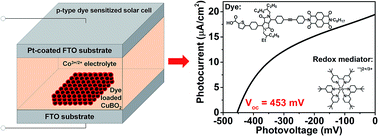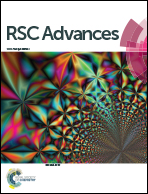Copper borate as a photocathode in p-type dye-sensitized solar cells†
Abstract
p-Type dye-sensitized solar cells (p-DSSCs) have recently become a major research focus because coupling with n-type DSSCs yields highly efficient tandem DSSCs. Indeed many delafossite-like compounds appear as promising candidates for p-DSSCs due to their deep valence band position and high hole mobility. In this paper, the synthesis of CuBO2 was attempted by a facile sol–gel methodology. Then, the as-obtained particles were used to prepare photocathodes for p-DSSCs with DPP-NDI dye as sensitizer and tris(4,4′-di-tert-butyl-2,2′-bipyridine)cobalt(III/II) as redox mediator. Due to the deeper valence band position compared with classical NiO photocathode, the “CuBO2” based p-DSSC presents an open-circuit photovoltage (Voc) of 453 mV, which is 150 mV higher than that of NiO in the same conditions. The results show that “CuBO2” is a potential alternative for NiO in p-DSSCs.


 Please wait while we load your content...
Please wait while we load your content...